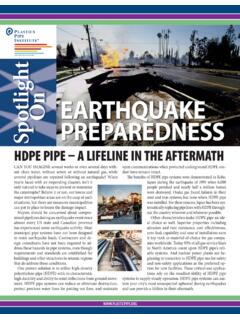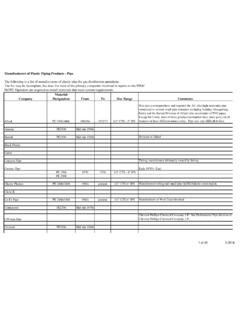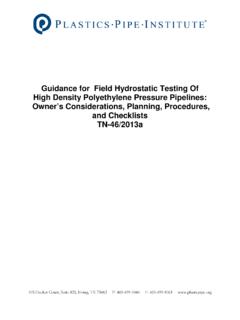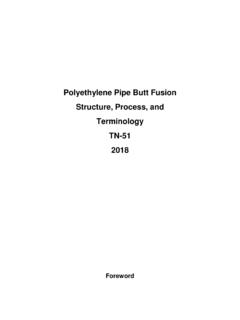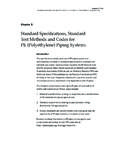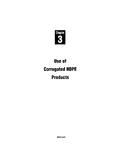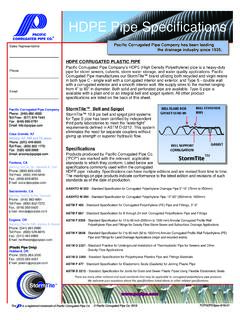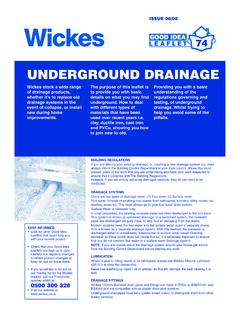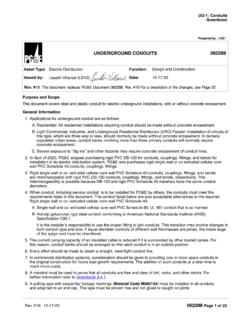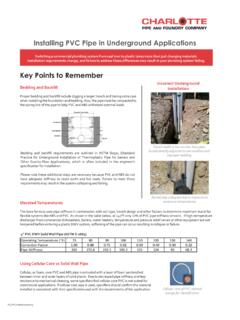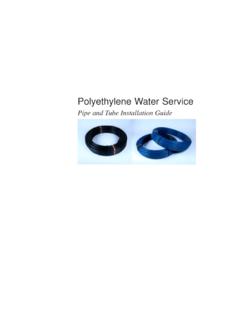Transcription of Underground Installation of PE Piping - plastic pipe
1 Chapter 7 Underground Installation of PE Piping265 Chapter 7 Underground Installation of PE PipingIntroductionPiping systems are prevalent throughout our everyday world. Most of us think of Piping systems as Underground structures used to convey liquids of one sort or another. To the novice, the concept of pipeline Installation Underground sounds relatively straight forward: a) dig a trench, b) lay the pipe in the trench, and c) fill the trench back in. While this simplified perspective of pipeline construction may be appealing, it does not begin to address the engineering concepts involved in the Underground Installation of a pipeline.
2 This chapter is written to assist in the development of a comprehensive understanding of the engineering principles utilized in the Underground Installation of PE pipe. In the pages which follow, the reader will be introduced to the concept of a pipe soil system and the importance that the soil and the design and preparation of the back-fill materials play in the long-term performance of a buried pipe structure. Specific terminology and design concepts relating to the Underground Installation of PE pipe will be fully discussed. This will include fundamental guidelines regarding trench design and the placement and subsequent backfill of the PE pipe.
3 This chapter is intended to assist the pipeline designer in the Underground Installation of PE Piping materials. This chapter is not intended as a substitute for the judgement of a professional engineer. Rather, it is felt that a comprehensive presentation of these design and Installation principles may assist the engineer or designer in utilizing PE pipe in a range of applications that require that it be buried beneath the earth. 2651/16/09 9:58:31 AMChapter 7 Underground Installation of PE Piping266 Flexible Pipe Installation TheoryPE Piping is considered flexible pipe. Flexible pipes can deflect up to their allowable deflection limit without damage.
4 Most PE pipes can withstand large amounts of deflection without damage but for practical purposes PE pipes are limited to deflection or less depending on the DR and application. For PE pipes, flexibility is directly proportional to the Dimension Ratio (DR). Low DR pipes such as DR have high resistance to deflection because their flexibility is very low, or conversely their stiffness is high. DR has a Pipe Stiffness (PS) per ASTM D2412 of about 1600 psi. On the other hand DR pipe has a PS of about psi. Such a wide range in flexibility across a product line means different Installation requirements for different DR s may be necessary to achieve successful and economical installations.
5 The depth of cover and anticipated surface loads also affect the particular Installation requirements. Therefore the engineer has to make an assessment of the application and site conditions to determine the best and most economical Installation design. Guidelines for doing this are given in Chapter 6. In general there are two objectives to achieve in an Installation . The first is to provide an envelope of embedment to protect the pipe from mechanical damage from impact or hard objects (cobbles, boulders) in the soil. The second is to provide support against earth and live load pressures, where this is required.
6 The envelope surrounding the pipe is referred to as the embedment . See Figure 1. The earth and live loads are supported by the combination of the pipe s stiffness and the embedment s stiffness. Lower DR pipes will carry more of the load and require less support from the soil. When support from the embedment is needed by the pipe to resist earth and live loads, the embedment material is often compacted. The trench backfill placed on top of the embedment material may also be compacted. Compaction of trench backfill immediately above the pipe facilitates the redistribution of some of the load away from the pipe and into the side-fill soil.
7 Terminology of Pipe Embedment MaterialsThe materials enveloping a buried pipe are generally identified, as shown by their function or location (see Figure 1). 2661/16/09 9:58:31 AMChapter 7 Underground Installation of PE Piping267 Figure 1 Pipe TrenchNote: When groundwater levels are expected to reach above the pipe, the secondary initial backfill should be a continuation of the primary initial backfill in order to provide optimum pipe support. Minimum trench width will depend on site conditions and embedment materials. Foundation - A foundation is required only when the native trench bottom does not provide a firm working platform for placement of the pipe bedding material.
8 Initial Backfill - This is the critical zone of embedment soil surrounding the pipe from the foundation to at least 6 inches over the pipe. The pipe s ability to support loads and resist deflection is determined by the quality of the embedment material and the quality of its placement. Within the initial backfill zone are bedding, haunching, primary, and secondary - In addition to bringing the trench bottom to required grade, the bedding levels out any irregularities and ensures uniform support along the length of the pipe. Haunching - The backfill under the lower half of the pipe (haunches) distributes the superimposed loadings.
9 The nature of the haunching material and the quality of its placement are one of the most important factors in limiting the deformation of PE pipe. Primary Initial Backfill - This zone of backfill provides the primary support against lateral pipe deformation. To ensure such support is available, this zone should extend from trench grade up to at least 75 percent of the pipe diameter. Under some conditions, such as when the pipe will be permanently below the ground water table, the primary initial backfill should extend to at least 6 inches over the pipe. 5 Figure 1 Pipe Trench Note: When groundwater levels are expected to reach above pipe, the secondary initial backfill should be a continuation of the primary initial backfill in order to provide optimum pipe support.
10 Minimum trench width will depend on site conditions and embedment materials. EDITORS NOTE: SHOW PIPE SPRINGLINE ON FIG. 1 DEFLECTION CONTROL As described previously, the load carrying capability of a PE pipe can be greatly increased by the soil in which it is embedded if, as the pipe is loaded, the load is transferred from the pipe to the soil by a horizontal outward movement of the pipe wall. This enhances contact between pipe and soil and mobilizes the passive resistance of the soil. This resistance aids in preventing further pipe deformation and contributes to the support for the vertical loads.

